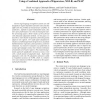Free Online Productivity Tools
i2Speak
i2Symbol
i2OCR
iTex2Img
iWeb2Print
iWeb2Shot
i2Type
iPdf2Split
iPdf2Merge
i2Bopomofo
i2Arabic
i2Style
i2Image
i2PDF
iLatex2Rtf
Sci2ools
ICPR
2008
IEEE
2008
IEEE
Rapid signer adaptation for continuous sign language recognition using a combined approach of eigenvoices, MLLR, and MAP
Current sign language recognition systems are still designed for signer-dependent operation only and thus suffer from the problem of interpersonal variability in production. Applied to signer-independent tasks, they show poor performance even when increasing the number of training signers. Better results can be achieved with dedicated adaptation methods. In this paper, we describe a vision-based recognition system that quickly adapts to new signers. For rapid signer adaptation it employs a combined approach of eigenvoices, maximum likelihood linear regression, and maximum a posteriori estimation. An extensive evaluation was performed on a large sign language corpus, that contains continuous articulations of 25 native signers. The proposed adaptation approach significantly increases accuracy even with a small amount of adaptation data. Supervised adaptation with only 10 adaptation utterances yields a recognition accuracy of 75.8%, which is a relative error rate reduction of 30.2% compa...
Adaptation Approach | Computer Vision | Dedicated Adaptation Methods | ICPR 2008 | Rapid Signer Adaptation |
| Added | 05 Nov 2009 |
| Updated | 05 Nov 2009 |
| Type | Conference |
| Year | 2008 |
| Where | ICPR |
| Authors | Christoph Blömer, Karl-Friedrich Kraiss, Ulrich von Agris |
Comments (0)

